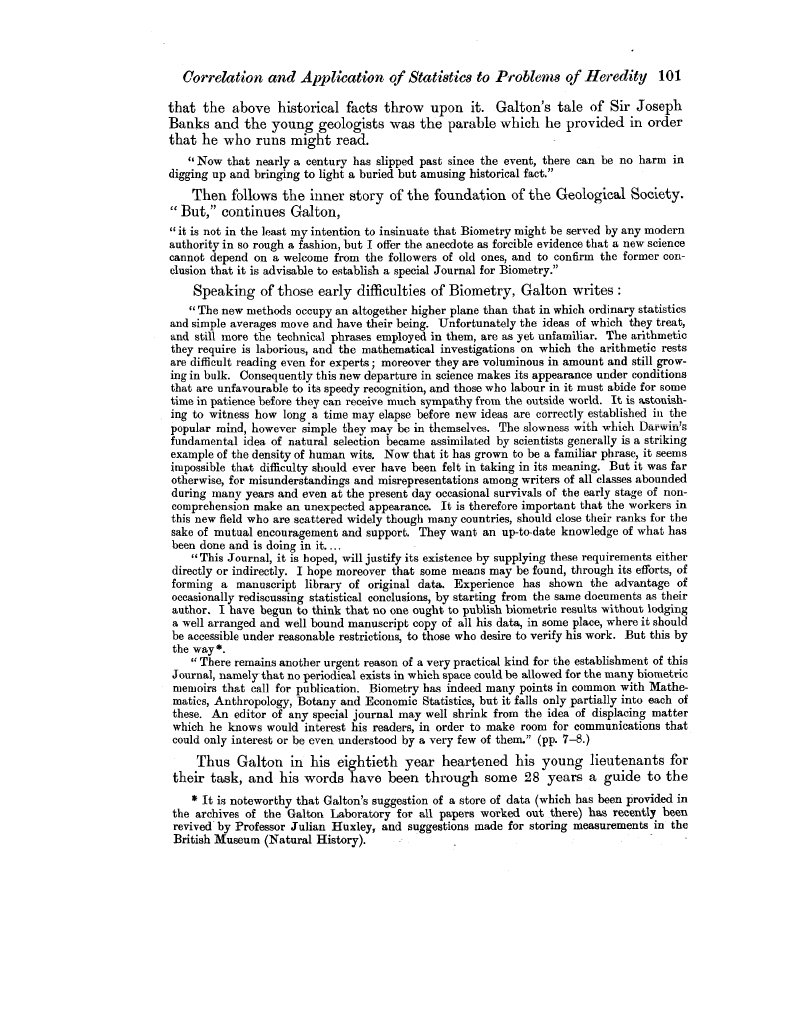| ||||||

OCR Rendition - approximate
Correlation and Application of Statistics to Problems of Heredity 101 that the above historical facts throw upon it. Galton's tale of Sir Joseph Banks and the young geologists was the parable which he provided in order that he who runs might read. " ° Now that nearly a century has slipped past since the event, there can be no harm in digging up and bringing to light a buried but amusing historical fact." Then follows the inner story of the foundation of the Geological Society. " But," continues Galton, t0 it is not in the least my intention to insinuate that Biometry might be served by any modern authority in so rough a fashion, but I offer the anecdote as forcible evidence that a new science cannot depend on a welcome from the followers of old ones, and to confirm the former conclusion that it is advisable to establish a special Journal for Biometry." Speaking of those early difficulties of Biometry, Galton writes "The new methods occupy an altogether higher plane than that in which ordinary statistics and simple averages move and have their being. Unfortunately the ideas of which they treat, and still more the technical phrases employed in them, are as yet unfamiliar. The arithmetic they require is laborious, and the mathematical investigations on which the arithmetic rests are difficult reading even for experts; moreover they are voluminous in amount and still growing in bulk. Consequently this new departure in science makes its appearance under conditions that are unfavourable to its speedy recognition, and those who labour in it must abide for some time in patience before they can receive much sympathy from the outside world. It is astonishing to witness how long a time may elapse before new ideas are correctly established in the popular mind, however simple they may be in themselves. The slowness with which Darwin's fundamental idea of natural selection became assimilated by scientists generally is a striking example of the density of human wits. Now that it has grown to be a familiar phrase, it seems impossible that difficulty should ever have been felt in taking in its meaning. But it was far otherwise, for misunderstandings and misrepresentations among writers of all classes abounded during many years and even at the present day occasional survivals of the early stage of noncomprehension make an unexpected appearance. It is therefore important that the workers in this new field who are scattered widely though many countries, should close their ranks for the sake of mutual encouragement and support. They want an up-to-date knowledge of what has been done and is doing in it.... "This Journal, it is hoped, will justify its existence by supplying these requirements either directly or indirectly. I hope moreover that some means may be found, through its efforts, of forming a manuscript library of original data. Experience has shown the advantage of occasionally rediscussing statistical conclusions, by starting from the same documents as their author. I have begun to think that no one ought to publish biometric results without lodging a well arranged and well bound manuscript copy of all his data, in some place, where it should be accessible under reasonable restrictions, to those who desire to verify his work. But this by the way*. " There remains another urgent reason of a very practical kind for the establishment of this Journal, namely that no periodical exists in which space could be allowed for the many biometric memoirs that call for publication. Biometry has indeed many points in common with Mathematics, Anthropology, Botany and Economic Statistics, but it falls only partially into each of these. An editor of any special journal may well shrink from the idea of displacing matter which he knows would interest his readers, in order to make room for communications that could only interest or be even understood by a very few of them." (pp. 7-8.) Thus Galton in his eightieth year heartened his young lieutenants for their task, and his words have been through some 28 years a guide to the * It is noteworthy that Galton's suggestion of a store of data (which has been provided in the archives of the Galton Laboratory for all papers worked out there) has recently been revived_ by Professor Julian Huxley, and suggestions made for storing measurements in the British Museum (Natural History).
|